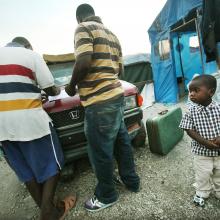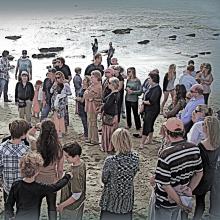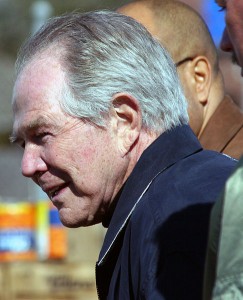Haiti
WE WERE LOOKING at cathedrals while others were mourning and burying their dead.
It was the first day of the international design competition that would help choose a few architectural plans that might be used to rebuild Notre Dame de l'Assomption, Our Lady of the Assumption, Port-au-Prince's most famous cathedral. This cathedral was so central to the city that, before it was leveled in the Jan. 12, 2010, earthquake, its turrets could be seen from most places in Port-au-Prince, as well as from the sea, where mariners used a light on the cupola of the church's north tower to help bring their ships home.
During the 2010 earthquake, the Catholic archbishop of Port-au-Prince, Monsignor Joseph Serge Miot, was killed inside an administrative building adjoining the cathedral, along with priests and parishioners. It was the images of their crushed bodies and their loved ones wailing around the perimeters of the cathedral's rubble that motivated me, a non-architect and non-Catholic—but a lover of cathedrals—to agree to join a development strategist, a preservationist architect, a structural engineer, a priest and liturgical consultant, the dean and associate dean of two architectural schools, and the editor of a magazine that discusses the dual issues of faith and architecture to help select three out of the 134 moving, elegant, and in some cases totally out-there designs that we had received from architects all over the world. Among the panelists, three of us were Haitian born, and many of the others had either worked in Haiti or in the Catholic Church for years.
The selection exercise itself was one that mirrored faith, blind faith. We were looking at sketches and plans but had no idea who had designed them. Some of the entries contained written statements that were so moving in their optimism for Port-au-Prince and its 3 million inhabitants, their hopes for Haiti and her people, and their longing for the rebuilt cathedral to serve as a symbol of renewal that they nearly brought me to tears.
Few narratives in the Hebrew Bible are more foreign to us than this week’s lection. We do not give away our children. In a society determined by socio-economic forces utterly beyond the control of individual citizens (e.g., globalization), we do our best to prepare ourselves for the inevitability of change. But what happens when we lose our footing?
Contemporary life changes too fast for habits and routines to have any chance to settle into a pattern. Western individuals must navigate their way through the fears and anxieties that are endemic to such an existence. Such is the pace of change, that effective life-strategies today may be obsolete tomorrow. We will do everything in our power to hold back the floods that threaten to wash away that which we hold dear — especially our children.
What was it like for parents in the Bible? Hannah, Samuel’s mother, was beset by another set of insecurities than those faced by contemporary Westerners. In the socio-economic situation of twelfth-century B.C.E., an Israelite woman’s worth was held in direct proportion to her fertility. Hannah was barren and thus her spirit was troubled to the point that she refused to eat, weeping instead on account of her “great anxiety and vexation” (1 Sam. 1:16 NRSV). In desperation, she made a vow before the LORD of hosts that if God would grant her a son, she would dedicate him to the LORD. The LORD heard Hannah’s prayer and blessed her with Samuel, whom she turned over to Eli the priest, according to her promise.
The Colorado wildfires are raging this week. I’m in Denver, and the grey haze over the mountains in the distance gives me a sick feeling. Countless trees on hundreds of thousands of acres have gone up in smoke. Hundreds of homes have been destroyed. Even human lives have now been forever lost to the flames. It’s tragic, and it’s not over yet.
But here’s what I believe. One day, when these fires have been extinguished, this land will be restored. People will do whatever it takes to reforest these hills and rebuild their homes. In a few years, mountainsides that are charred and blackened today will be green again. We have the will and the resources to restore our environment when it has been destroyed.
Two weeks ago I was in Haiti. Unlike the deforestation that has happened in Colorado in a matter of days, Haiti’s 98-percent deforestation has happened over centuries. The destruction to Haiti’s natural environment is almost complete. Birds are rare. Small animals are almost gone. Fish that once teemed in the waters around the island are barely there.
It gets worse.
The Spring Equinox ushers in World Storytelling Day. Listen to Portlandia stars discuss some of their most cherrished music. OK Go experiments with a new online dating service. Arcade Fire delivers guest lecture at University of Texas at Austin. Pictures of sharks, crazy sool ice-cream shops, and more...

Port-au-Prince church post-earthquake. Photo by Colin Crowley via Wylio http://www.wylio.com/credits/Flickr/4293703467
How does one dig out from under such tragedy? How does one have hope for a better life, for a new Haiti?
In a meditation titled "The Gates of Hope," Minister Victoria Safford writes:
"Our mission is to plant ourselves at the gates of hope -- not the prudent gates of Optimism, which are somewhat narrower; nor the stalwart, boring gates of Common Sense; nor the strident gates of self-righteousness ... nor the cheerful, flimsy garden gate of 'Everything is gonna be all right,' but a very different, sometimes very lonely place, the place of truth-telling, about your own soul first of all and its condition, the place of resistance and defiance, the piece of ground from which you see the world both as it is and as it could be, as it might be, as it will be; the place from which you glimpse not only struggle, but joy in the struggle — and we stand there, beckoning and calling, telling people what we are seeing, asking people what they see."
Indeed, we need to plant ourselves at the gates of hope and work toward a just peace, on Earth as it is in heaven.
To me, "unexpected" is at the heart of how I understand grace. It is the unearnable gift, the divine reversal and sacred surprise, the still small voice that drowns out the din of the maddening crowd, the little bit extra that my Cajun friends call lagniappe, the very thing we "deserve" the least but get anyway. From God. From the One who created the world and the audacious, indescribably power of love.
Taking a cue from Nell, here are just a few of the unexpected blessings I am grateful for today:
For God's fingerprints that cover every inch of our world, seen and unseen. And for the moments where I can almost make out the holy whirls imprinted in the sky, the ocean, the sunlight, and on the faces and stories of each of us.
For the generosity and selflessness I see so vividly — all around me, all the time — even in these lean, nervous days. I saw it in Zuccotti Park, where strangers prepared and served food to other strangers. I saw it in the sober faces and strong arms of the men who helped 84-year-old Dorli Rainey to safety after she was pepper-sprayed at an Occupy rally in Seattle. I heard it in the prayers lifted at the White House, at North Park University in Chicago, and in the basement of a church in Spanish Harlem where kind, mighty souls formed Human Circles of Protection last week and stood in solidarity with the poor, the vulnerable, and the least of those among us. I watched it on display at border crossings, immigration rallies, refugee camps in the Horn of Africa, and at a glass blower's studio in my hometown of Laguna Beach where strangers arrived with shovels and wheelbarrows to help dig out an artist and his artwork from the muddy ravages of a flash flood. I saw it in the fresh coat of paint on the front steps of my elderly parents' home in Connecticut that my cousins had applied for them with great care and kindness when my brother and I couldn't be there to do it.
My daughter attended her first day of kindergarten today. A poignant milestone dressed up in an exceptionally cute plaid jumper.
My wife and I thought we were pretty cool with it. Our daughter had attended preschool, after all, so this wasn't a major logistical change. She was excited as we dropped her off, said goodbye with a smile over her shoulder, then back to drawing in her new notebook.
We still thought we were cool with it after we signed up for PTA at the courtyard table. We ran into the local rabbi. My wife is pastor at a Lutheran church in town and they cross paths regularly. The rabbi's third child was starting kindergarten. He's an old hand at this.
Some sources have stated that more than 12 million people are being impacted by the worst drought and famine in the region of the Horn of Africa in 60 years.
12 million people.
How do you wrap your head around such a number?
12,000,000
You begin with one.
The World Food Programme, for example, has shared that they can provide a nutritious meal for one person for .17
To commemorate the anniversary of the devastating earthquake in Haiti, the Haiti Partners youth choir, WOZO, sings about those who have pas
There's been considerable rain where we live in Haiti, and there are also wind gusts. I fear for folks in Leogane and elsewhere who are vulnerable to flooding.
Driving today through Port-au-Prince in the glaring summer sun, there is still plenty of rubble being removed. Presumably, almost seven months after the earthquake, bodies are still being discovered.




